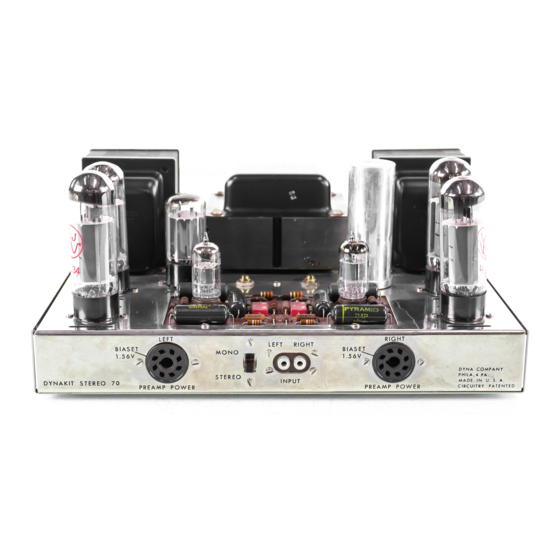DYNACO Stereo 70 Instructies voor montage - Pagina 11
Blader online of download pdf Instructies voor montage voor {categorie_naam} DYNACO Stereo 70. DYNACO Stereo 70 16 pagina's. Series ii tube amplifier
Ook voor DYNACO Stereo 70: Restauratie Handboek (20 pagina's), Restauratie Handboek (5 pagina's), Gebruikershandleiding (12 pagina's)

smooth transition of sound between the speakers.
If
it
is
not correct, there will be an intermediate
area where the sound will shift -from one to the
other.
If
phasing is not correct, it can be rectified
by interchanging the two leads between one of the
amplifier c h ann e I s and its associated speaker.
There should be no need to change phasing once
the system is set up properly.
Proper phasing
of
the stereo pickup or tape
head is generally accomplished by the manufac-
turer of this item. However, this can be inverted in
installation if directions are not followed precisely.
If
there is a drop in volume using a monophonic
tape or disc, this indicates probable incorrect
phasing.
An
interchange of ground and "hot" side
of one of the cartridge channels or of the two leads
to one channel of the tape head will remedy this
type of incorrect phasing.
Hum is another problem which the stereo disc
playback cartridge can introduce.
In
some cases
(particularly where independent preamps are used
for the two channels) the use of a common ground
lead on the two inputs will provoke a hum condi-
tion. For this reason, many stereo pickup manu-
facturers provide separate ground connections for
each channel by using four cartridge terminals.
The cable shields of the two channels should be
kept separated.
If
a three terminal magnetic cartridge arrange-
ment is used, it is very possible that hum will be
encountered if the equipment from the two channels
has any additional interchannel connection (beside
the common shield from the pickup). Connection
of the Stereo 70 should not give this trouble. How-
ever, dissimilar units in each channel can be a
source of hum when three terminal cartridges are
used.
Crystal and ceramic cartridges which go
into high level inputs should not normally introduce
this type of hum problem.
Positioning of loudspeakers will af fee t the
quality of stereophonic reproduction.
Generally,
moderate distances of six to ten feet along the
same wall pro vi d e the best effect.
If
greater
spacing is required, the use of a blend control can
help to provide "fill" in the middle. However, if
extreme distance is required, a "phantom" middle
channel is useful.
It
has generally been established
that an L
+
R combination of the two channels pro-
vides the best center fill. Information on the proper
method for obtaining this signal, using either the
two regular stereo amplifiers, or a third ampli-
fieI', may be obtained on request from Dynaco,
Inc. This arrangement will also provide a com-
bined signal for a remote monophonic extension
speaker.
In most rooms, the proper balance of the
stereo system will be different for different listen-
ing positions.
If
the listening positions are rela-
tively far from the s pea k e
I'
s, this problem is
diminished, and' optimum results are obtainable
for several listening positions simultaneously.
The most basic consideration of the installation
and use of a stereophonic system is that stereo
alone does not create realism and high quality
sound.
Two low grade stereo channels will not
give the qua 1it
Y
of one high grade monophonic
channel.
There is no substitute for high quality
components, carefully installed.
IN CASE OF TROUBLE
Your Dynakit Stereo 70 has been designed to be
as free from trouble as possible.
However, a
mistake in assembly or a defective component can
affect its performance or m a k e it inoperative.
Some trouble-shooting procedures are suggested
in case difficulty is encountered.
Naturally the
wiring should be checked very carefully to make
sure that all con nee t ion s have been made in
accordance with instructions.
The tubes should light after a few seconds of
warmup.
If
they do not, it is probable that there
is no ac voltage getting into the amplifier, which
indicates a possible blown fuse.
Fuse failure
If fuses blow frequently without apparent cause,
this may sometimes be rectified by using a slow
blow type of fuse. However, do not exceed the 3
ampere fuse rating when replacing fuses.
If
fuses blow within 30 seconds of turning the
amplifier on, remove the GZ -34 rectifier tube and
see if this cures the problem.
If
it does, the
rectifier may be bad and another should be tried.
A 5U4GB type of rectifier can be substituted for
trial purposes, although using this tube type will
cut down the maximum power rating of the ampli-
fieI'.
If
the GZ -34 is not at fault, the quadruple
section filter capacitor may be snorted. Generally,
shorts in this section of the amplifier will show up
in a measurement of resistance (with the amplifier
unplugged from the 117 volt line) from capacitor
to ground. This resistance should exceed 100,000
ohms.
Fuses blowing with all tubes removed indicate
either m i s wi
l'
in g or a defective P A-060 power
transformer.
Tubes glowing
If
one (or a pair) of the EL-34's glows a bright
red color after slight warmup, it is possible that
the tube is bad, or there may be a fault in the bias
supply which supplies neg at i v e voltage to the
EL-34' s, measurable (with a high impedance meter
such as a VTVM) at pin #5 of each EL-34. The
9
